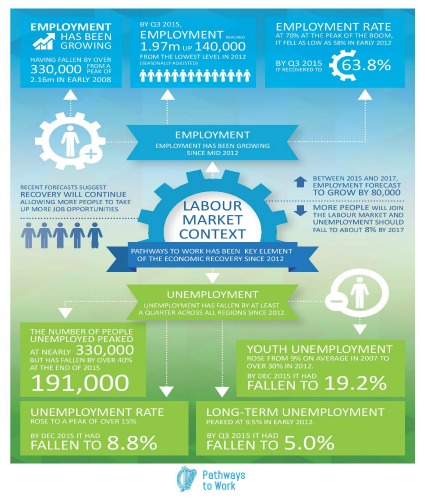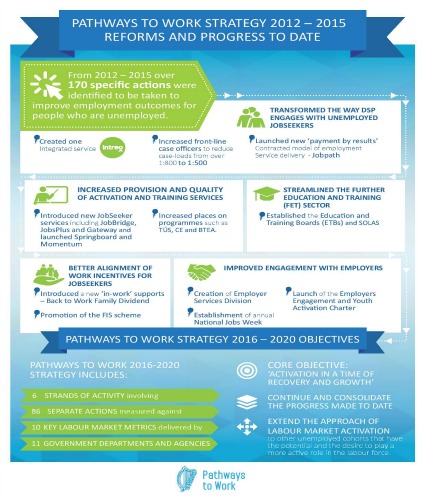 Taoiseach Enda Kenny and Minister Jan O'Sullivan with (l-r) Angela Smith, Head of Corporate Social Responsibility at Diageo Ireland; Lorraine O'Connor, Hayleigh Foran and Daniel O'Callaghan who completed a Pathways to Work programme and found employment at the Guinness Storehouse
Taoiseach Enda Kenny and Minister Jan O'Sullivan with (l-r) Angela Smith, Head of Corporate Social Responsibility at Diageo Ireland; Lorraine O'Connor, Hayleigh Foran and Daniel O'Callaghan who completed a Pathways to Work programme and found employment at the Guinness Storehouse
Increasing the number of people in employment in Ireland to 2.2 million by 2020 - that's the key aim of Government latest Pathways to Work strategy launched this week. Pathways to Work 2016 – 2020 will see 86 dedicated actions implemented over the next five years to get unemployed people back to work.
The strategy focuses on six key strands which aim to:
- enhance employment, education and training services for jobseekers
- continue with reforms to make work pay
- increase engagement with employers to provide greater opportunities for those seeking work.
Interested in finding out more about strategy? We've three things to know about Pathways to Work.
What is Pathways to Work?
Pathways to Work is a key Government strategy which focuses on making sure that as many as possible of new jobs, and other vacancies that arise in the economy, are filled by people from the Live Register. Pathways to Work is coordinated by the Department of Social Protection, working together with a number of other Departments and Agencies.
It is designed to complement the Action Plan for Jobs as part of a twin-pronged approach to tackling the jobs crisis that emerged in the final years of the last decade.
The Pathways to Work strategy for the next five years will build on the success of first Pathways to Work which ran from 2012-2015.

What's involved in Pathways to Work 2016-2020?
The strategy for the next five years will see 86 actions being implemented, including increasing the frequency of case officer meetings with jobseekers; expanding apprenticeships; rolling out JobPath, introducing a new First Steps work experience and training programme for disadvantaged young people; and redeveloping jobsireland.ie. The actions will be implemented under six different strands:
Strand 1: Enhanced engagement with jobseekers – This will see the Department of Social Protection continue to improve the quality of engagement between the Intreo service and jobseekers, focusing on helping the long-term unemployed.
Strand 2: Increase the employment focus of activation programmes and opportunities – This will see more work placements, education and training opportunities at local and regional levels.
Strand 3: Making work pay: incentivise the take-up of opportunities – This will ensure that jobseekers have a financial incentive to work through tax, welfare and employment policies.
Strand 4: Incentivise employers to offer jobs and opportunities to unemployed people – This involves incentivising employers to offer opportunities for jobseekers and assist them in recruiting from the Live Register.
Strand 5: Continue to build organisation capability to deliver high quality services to unemployed people – This involves continuing to overhaul employment services to enhance them for both jobseekers and employers.
Strand 6: Building the workforce – This is working with the education and training sectors to ensure they are aligned with the needs of employers, workers and jobseekers.
What are results of the strategy to date?

Since the first Pathways to Work was announced, the number of unemployed people in Ireland has dropped by around 42%. 60 new and refurbished Intreo Centres were established across the country, while the number of caseworkers dealing with jobseekers was doubled. Schemes including the Youth Guarantee, JobsPlus, JobPath and the Back to Work Family Dividend have also been put in place.
For more information
Read the full Pathways to Work strategy document.